Knowing how to use and understand Italian pronouns is essential for Italian fluency. But they can be tricky. Master your Italian pronouns with this detailed guide full of helpful tips.
This guide will walk you through the key types of Italian pronouns and show you how they can transform your texts and conversations. And to bring it all home, I’ve included a fun and interactive quiz at the end of this guide so you can practice your new-found Italian grammar skills.
Before we get started, make sure you download your FREE PDF cheat-sheet for this lesson which includes a practical summary of everything you’ll learn in this guide. Just enter your email below and I’ll send it to you straight away.
By the way, want to improve your Italian quickly and having fun doing it?
I thought so.
If you’re a beginner, I recommend Intrepid Italian, my comprehensive self-paced programme that teaches you through the power of my unique 80/20 method. The course covers everything you need to know as a beginner in Italian (including how to use pronouns). Join now for lifetime access and my 30-Day “Celebrate with a Spritz” money-back guarantee by clicking here.
Or if you’re already at the intermediate level, why not enrol in Intrepid Italian for Advanced Beginners (A2) or Intrepid Italian for Intermediates (B1), my more advanced programmes that helps you master the trickiest aspects of Italian grammar while as you edge closer to fluency in Italian.
When you start learning Italian, it’s pretty common to keep repeating the same basic phrases and words, but if you’re gunning for fluency, it’s time to shake things up a bit. The key? Familiarize yourself with Italian pronouns to inject rhythm into your sentences!
Cominciamo! (Let’s get started!)
What Are Pronouns?
Pronouns are tiny little words that step in to replace parts of a sentence. They not only save us from sounding like a broken record but also jazz up our Italian, making it more lively and fluent. The word “pronoun” itself makes their role very clear. Coming from the Latin “pronomem,” where “pro” means “for” and “nomen” is “name,” they essentially stand in “for a name.”
Consider this example:
- Marco ha chiamato Anna; vuole invitare Anna al cinema. (Marco has called Anna; he wants to invite Anna to the movies.)
- Marco ha chiamato Anna, vuole invitarla al cinema. (Marco has called Anna, he wants to invite her to the movies.)
In the second sentence, la is an Italian pronoun used to replace Anna, so the sentence flows smoother and isn’t repetitive.
Italian pronouns are super useful words like io, tu, lo, la, and so on (equivalent to I, you, him, her in English) that take the place of other words in a sentence. They help avoid repeating the same thing over and over, making things clearer and easier to follow.
| Key Italian Pronouns | ||
|---|---|---|
| Personal Pronouns | Possessive Pronouns | Relative Pronouns |
| They indicate who or what is involved within a sentence, be it either the subject or the object (io, te, lo, etc., equivalent to I, you, him, etc. in English) | They express possession and belonging, indicating to whom the referred elements belong (mio, tuo, suo, etc., equivalent to mine, yours, his, etc. in English) | They connect two sentences by referring back to a noun mentioned in the first sentence (che, cui, il quale, etc…, equivalent to which, that, etc. in English) |
Understanding Italian Pronouns
Pronouns in Italian, much like in English, serve as substitutes for nouns – whether they are people, animals, objects, or abstract ideas. But Italian boasts a more complex system of pronouns compared to English, which can cause quite a few headaches.
Understanding the different types of Italian pronouns and how they fit into sentences is a key part of mastering this aspect of the language. So, let’s break them down into a few main types, each playing a distinct role in Italian grammar. We’ll explore each category in this guide, so you can get a handle on them:
Italian Personal Pronouns
Personal pronouns are used to indicate the person or thing involved in the action of the verb. This can be either the subject (i.e., who is performing the action) or the object (i.e., who is receiving the action) in the sentence.
Here are some some examples:
- Noi andremo al cinema, ma loro preferiscono restare a casa. (We will go to the cinema, but they prefer to stay at home.)
Here, noi and loro are plural personal pronouns used as subjects in the sentences.
- Maria è andata da Eleonora, la aiuterà con i compiti di matematica. (Maria went to Eleonora’s, she will help her with her math homework.)
Here, the personal pronoun la replaces Maria, indicating that Maria is the one who will be helped.
There are four types of personal pronouns in Italian:
| Italian Personal Pronouns | |||
|---|---|---|---|
| Subject Pronouns | Direct Object Pronouns | Indirect Object Pronouns | Reflexive Pronouns |
| They replace the subject in a sentence (e.g., io, tu, lei, corresponding to I, you, she, etc. in English) | They replace the direct recipient of the action in a sentence (e.g., me, te, lo, etc. corresponding to me, you, him, etc. in English) | They replace the indirect recipient of the action in a sentence (e.g., me, te, la, etc. corresponding to me, you, her, etc. in English) | They indicate that the person or object performing the action of the verb is also the recipient of that action (e.g., mi, ti, si, etc. corresponding to myself, yourself, herself, etc. in English) |
Italian Subject Pronouns Chart
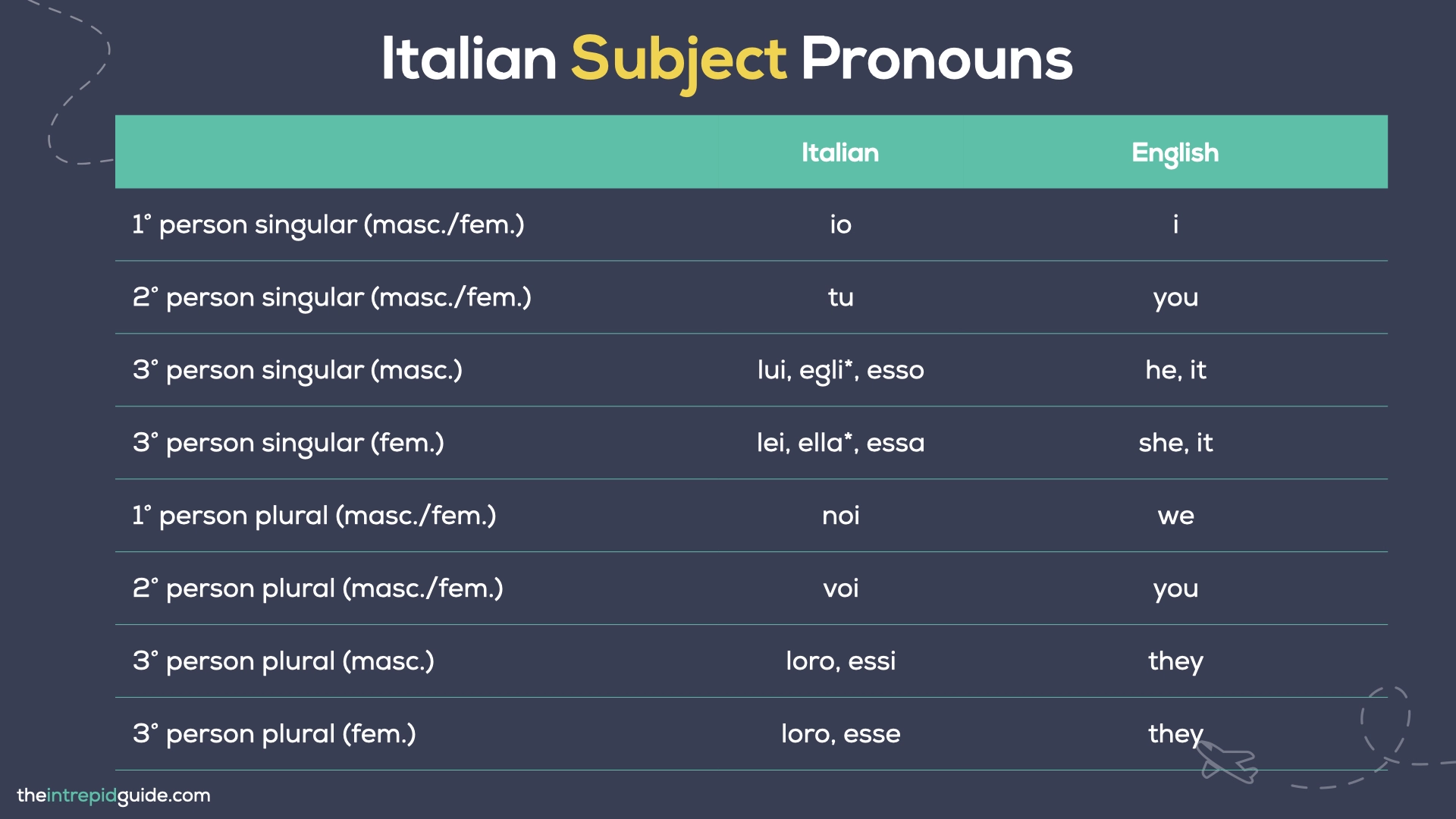 Subject pronouns in Italian are essential for understanding who or what is performing an action. They replace the subject in a sentence, which can be a person, animal, or object. These pronouns are typically among the first elements you learn in Italian, as they are key to correctly conjugating verbs.
Subject pronouns in Italian are essential for understanding who or what is performing an action. They replace the subject in a sentence, which can be a person, animal, or object. These pronouns are typically among the first elements you learn in Italian, as they are key to correctly conjugating verbs.
| Italian Subject Pronouns | ||
|---|---|---|
| Italian | English | |
| 1 person singular (masc./fem.) | io | i |
| 2 person singular (masc./fem.) | tu | you |
| 3 person singular (masc.) | lui, egli*, esso | he, it |
| 3 person singular (fem.) | lei, ella*, essa | she, it |
| 1 person plural (masc./fem.) | noi | we |
| 2 person plural (masc./fem.) | voi | you |
| 3 person plural (masc.) | loro, essi | they |
| 3 person plural (fem.) | loro, esse | they |
* In everyday Italian, the subject pronouns egli and ella have become archaic and are only used in highly formal or bureaucratic contexts.
Here are some examples:
- Ho conosciuto Anna sull’aereo; lei è di Roma e tornava a casa per il Natale. (I met Anna on the plane; she’s from Rome and was heading home for Christmas.)
Here, lei is the subject pronoun referring back to Anna.
- Io vado a comprare qualcosa da mangiare, mentre tu fai la fila per i biglietti. (I’m going to buy something to eat, while you wait in line for the tickets.)
Here, io is the subject pronoun for the first person singular, indicating the action taken by the speaker, while tu is the subject pronoun for the second person singular, referring to the person the speaker is talking to.
- Chiama Andrea e Giulio, loro sapranno consigliarti un buon hotel in città. (Call Andrea and Giulio, they will be able to recommend a good hotel in the city.)
Here, loro is the subject pronoun referring back to Andrea e Giulio.
Click here to learn more about subject pronouns in Italian
Italian Direct Object Pronouns Chart
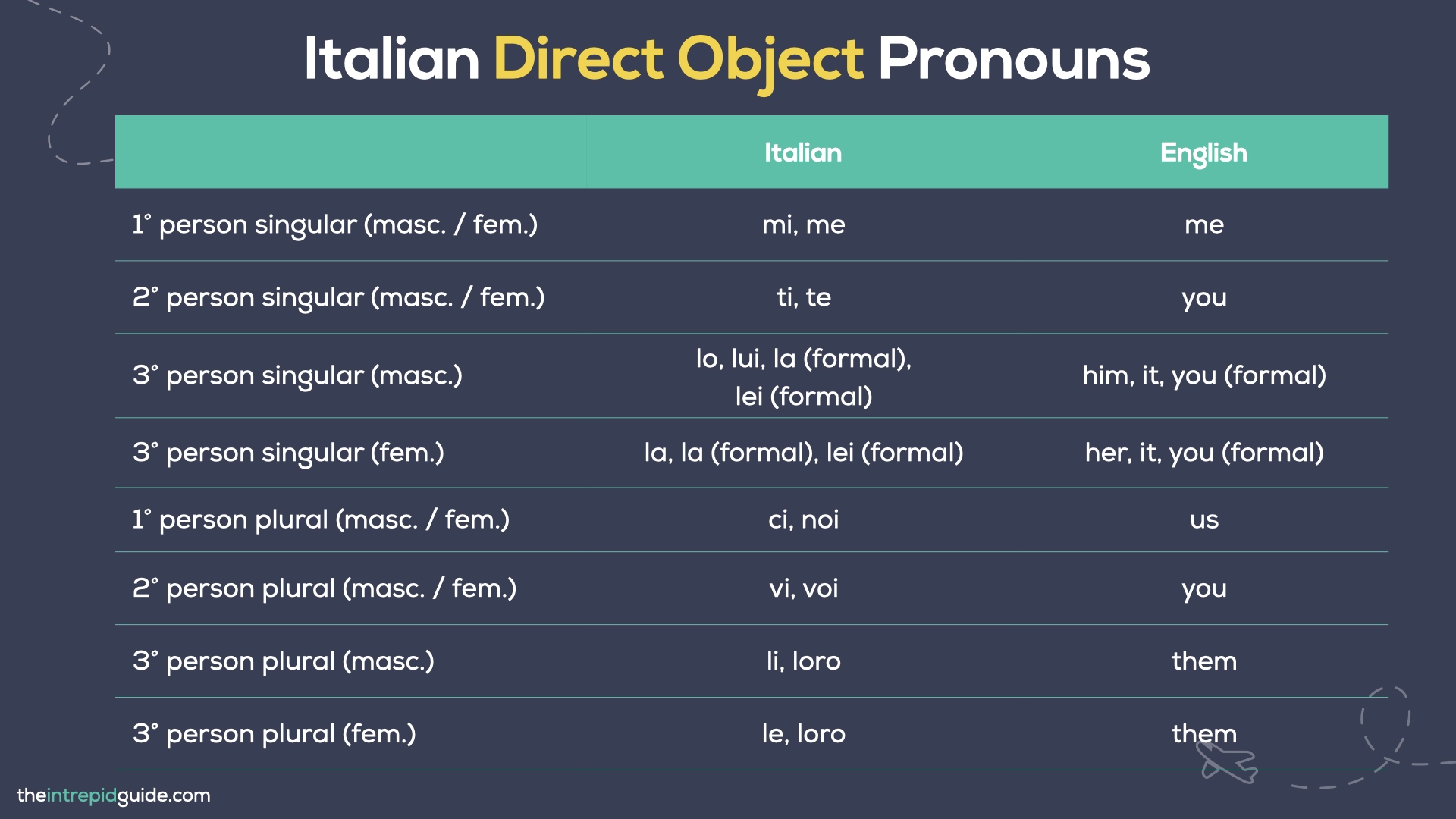 Direct object pronouns are used to replace the noun that directly receives the action of a verb. To identify them, simply ask yourself: does the pronoun answer ‘who?’ or ‘what?’ in relation to the verb’s action?
Direct object pronouns are used to replace the noun that directly receives the action of a verb. To identify them, simply ask yourself: does the pronoun answer ‘who?’ or ‘what?’ in relation to the verb’s action?
For example, in the sentence Vedo la macchina (I see the car), la macchina (the car) is the direct object. It can be replaced with the pronoun la, as in la vedo. This la is the direct object pronoun, answering the question ‘what do I see?’
| Italian Direct Object Pronouns | ||
|---|---|---|
| Italian | English | |
| 1° person singular (masc. / fem.) | mi, me | me |
| 2° person singular (masc. / fem.) | ti, te | you |
| 3° person singular (masc.) | lo, lui, la (formal), lei (formal) | him, it, you (formal) |
| 3° person singular (fem.) | la, la (formal), lei (formal) | her, it, you (formal) |
| 1° person plural (masc. / fem.) | ci, noi | us |
| 2° person plural (masc. / fem.) | vi, voi | you |
| 3° person plural (masc.) | li, loro | them |
| 3° person plural (fem.) | le, loro | them |
Usually, we put direct object pronouns right before the verb. However, there are exceptions, such as with imperative verbs, where you stick them onto the end of the verb to form a single word.
Here are some examples:
- È da un’ora che aspetto Giovanni. —> È da un’ora che lo aspetto. (I’ve been waiting for Giovanni for an hour. —> I’ve been waiting for him for an hour.)
lo replaces Giovanni
- Voglio vedere solo Stefania. —> Voglio vedere solo lei.(I want to see only Stefania. —> I want to see only her.)
Lei replaces Stefania
- Chiama subito Anna e Paola! —> Chiamale subito! (Call Anna and Paola right away! —> Call them right away!)
Le replaces Anna e Paola
Click here to learn more about direct object pronouns in Italian
Italian Indirect Object Pronouns Chart
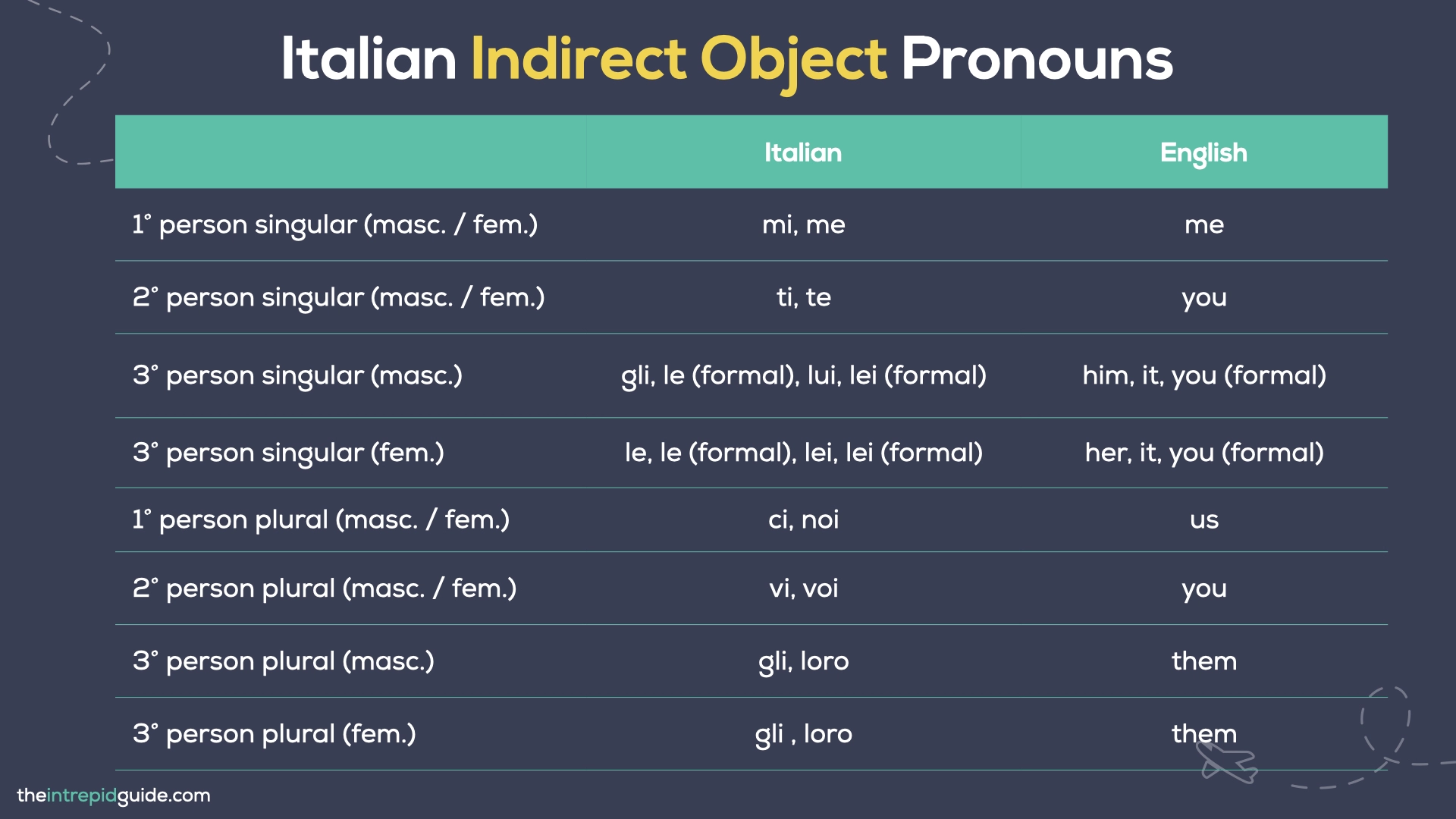 Indirect object pronouns are used to indicate the person or thing that is the recipient of an action. They answer the question “to whom” or “for whom” a certain thing is done.
Indirect object pronouns are used to indicate the person or thing that is the recipient of an action. They answer the question “to whom” or “for whom” a certain thing is done.
For example, in the sentence Porto un regalo a Matteo, un regalo is what’s being given (the direct object), while Matteo is the guy receiving the present (the indirect object) and can be replaced with gli, as in Gli porto un regalo. This gli is our handy indirect object pronoun.
| Italian Indirect Object Pronouns | ||
|---|---|---|
| Italian | English | |
| 1° person singular (masc. / fem.) | mi, me | me |
| 2° person singular (masc. / fem.) | ti, te | you |
| 3° person singular (masc.) | gli, le (formal), lui, lei (formal) | him, it, you (formal) |
| 3° person singular (fem.) | le, le (formal), lei, lei (formal) | her, it, you (formal) |
| 1° person plural (masc. / fem.) | ci, noi | us |
| 2° person plural (masc. / fem.) | vi, voi | you |
| 3° person plural (masc.) | gli, loro | them |
| 3° person plural (fem.) | gli , loro | them |
Here are some examples:
- Ho fatto un regalo a Gianni. —> Gli ho fatto un regalo. (I gave Gianni a gift. —> I gave him a gift.)
Gli replaces a Gianni
- Mario ha chiesto a Elena se vuole venire con noi a Milano. (Mario asked Elena if she wants to come with us to Milan.)
becomes…
- Mario le ha chiesto se vuole venire con noi a Milano. (Mario asked her if she wants to come with us to Milan.)
Le replaces a Elena
Here is another example:
- Hanno chiesto a noi di organizzare l’itinerario.(They asked us to organize the itinerary)
becomes
- Ci hanno chiesto di organizzare l’itinerario. (They asked us to organize the itinerary.)
Ci replaces a noi
Click here to learn more about indirect object pronouns in Italian
Italian Reflexive Pronouns Chart
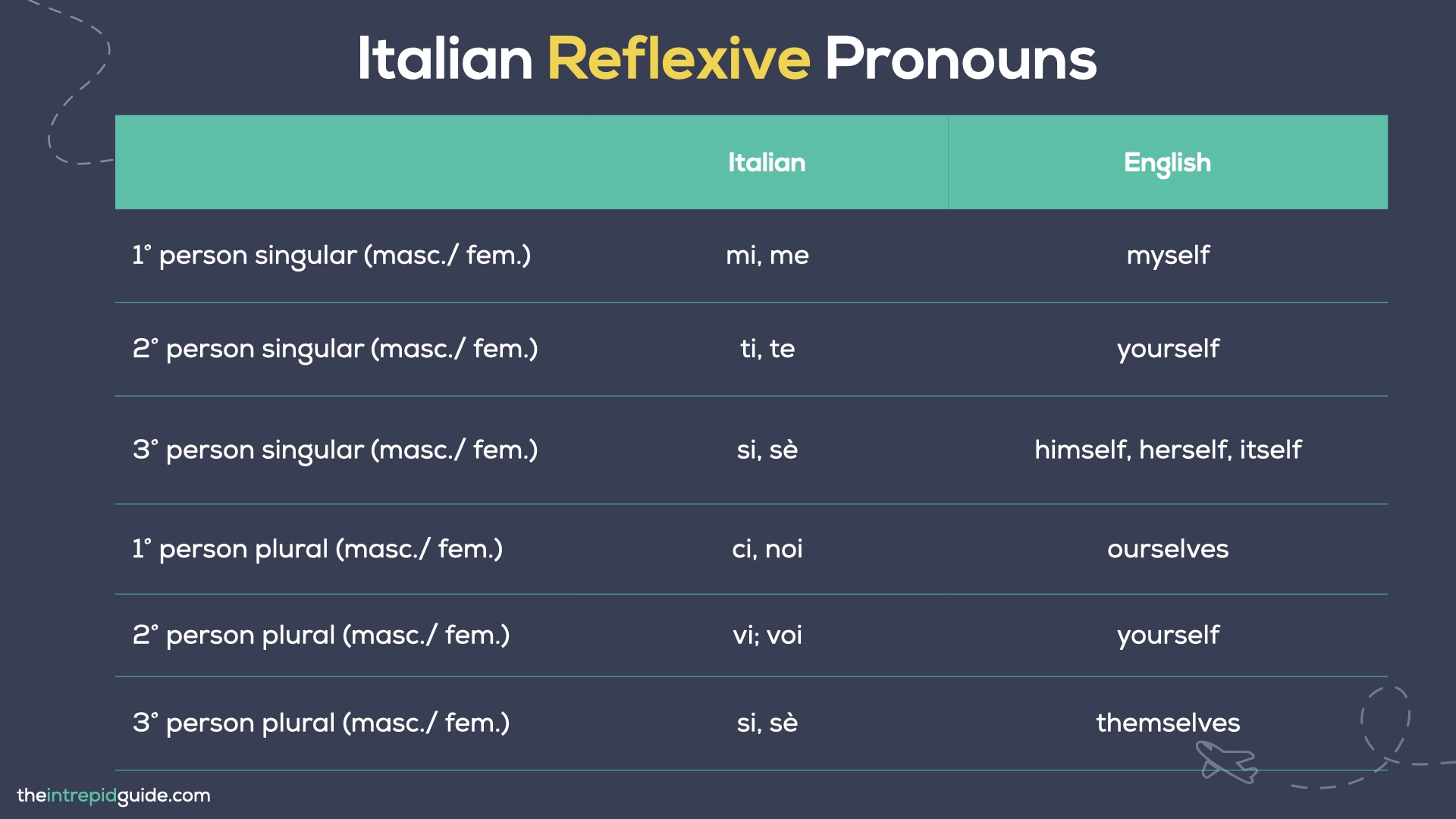 Reflexive pronouns are a specific category of personal pronouns used when the subject of a sentence performs an action on itself. In other words, these pronouns step in when the same noun is both the subject doing the action and the object receiving it.
Reflexive pronouns are a specific category of personal pronouns used when the subject of a sentence performs an action on itself. In other words, these pronouns step in when the same noun is both the subject doing the action and the object receiving it.
| Italian Reflexive Pronouns | ||
|---|---|---|
| Italian | English | |
| 1° person singular (masc./ fem.) | mi, me | myself |
| 2° person singular (masc./ fem.) | ti, te | yourself |
| 3° person singular (masc./ fem.) | si, sè | himself, herself, itself |
| 1° person plural (masc./ fem.) | ci, noi | ourselves |
| 2° person plural (masc./ fem.) | vi; voi | yourself |
| 3° person plural (masc./ fem.) | si, sè | themselves |
Reflexive pronouns are commonly paired with reflexive verbs, which indicate that the subject of the sentence is performing an action on themselves. Examples of such verbs include lavarsi (to wash oneself), alzarsi (to get up), and pettinarsi (to comb one’s hair). In a sentence, reflexive pronouns usually come before the verb.
Here are some examples:
- Ci vediamo tutti i fine settimana. (We see each other every weekend.)
Ci indicates that the action of seeing each other is performed by the subjects on themselves. Instead, if we say Vediamo i nostri amici tutti i fine settimana (We see our friends every weekend), that same action is directed towards others – the friends – not the subjects themselves.
- Mi vesto e vado a fare colazione. (I dress myself and go have breakfast.)
Mi indicates that the action of getting dressed is being performed on the speaker.
- Ieri si è tagliato facendosi la barba. (Yesterday he cut himself while shaving.)
Si indicates that the action of cutting is performed by the subject on himself.
Click here to learn more about reflexive pronouns in Italian
Italian Possessive Pronouns Chart
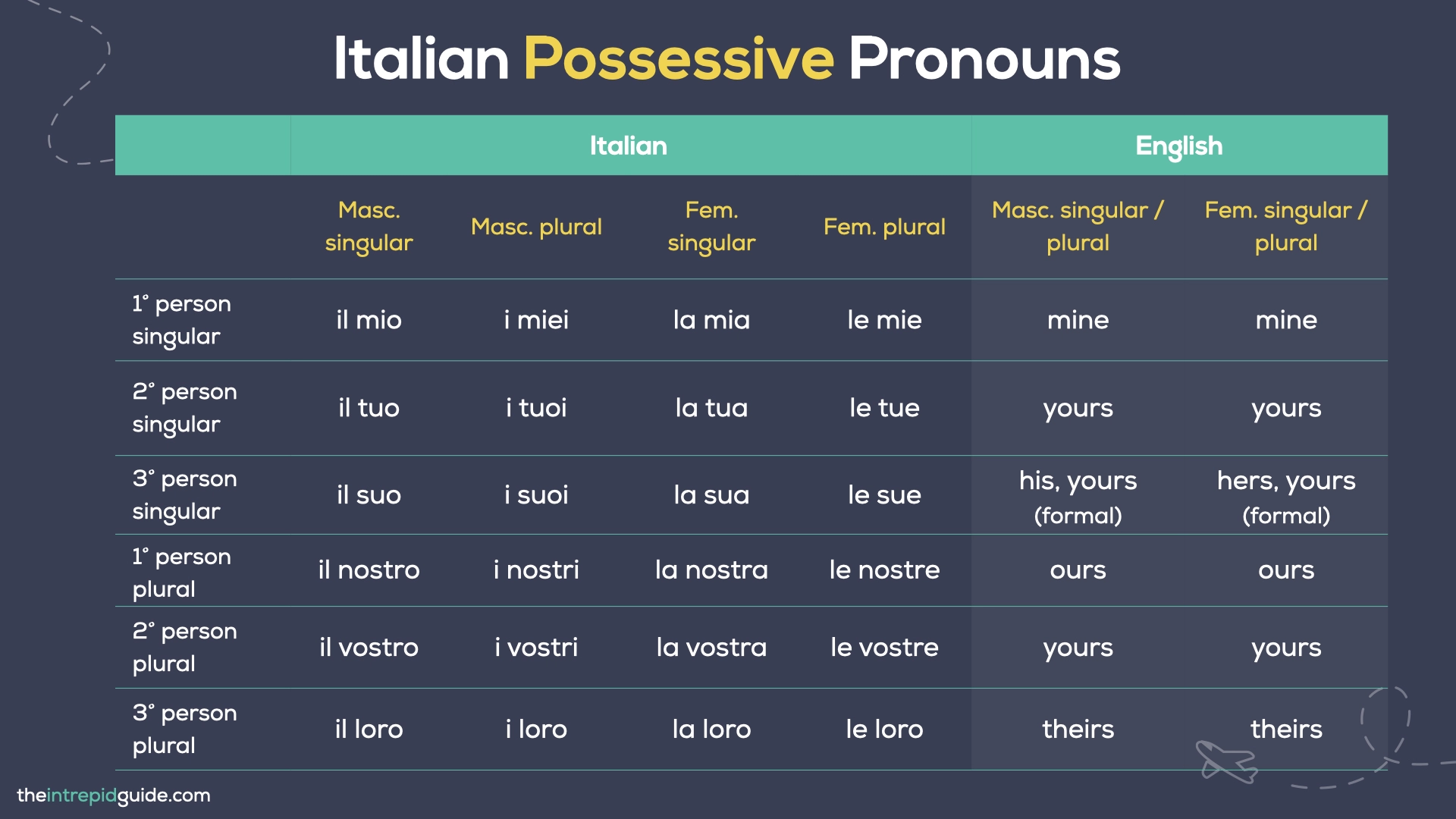 Possessive pronouns are used to indicate ownership of a person or object, which is specified by the noun they substitute. They are commonly introduced by a definite article that matches the gender and number of the noun they refer to, like il (the) or le (the).
Possessive pronouns are used to indicate ownership of a person or object, which is specified by the noun they substitute. They are commonly introduced by a definite article that matches the gender and number of the noun they refer to, like il (the) or le (the).
| Italian Possessive Pronouns | ||||||
|---|---|---|---|---|---|---|
| Italian | English | |||||
| Masc. singular | Masc. plural | Fem. singular | Fem. plural | Masc. singular / plural | Fem. singular / plural | |
| 1° person singular | il mio | i miei | la mia | le mie | mine | mine |
| 2° person singular | il tuo | i tuoi | la tua | le tue | yours | yours |
| 3° person singular | il suo | i suoi | la sua | le sue | his, yours (polite) | hers, yours (polite) |
| 1° person plural | il nostro | i nostri | la nostra | le nostre | ours | ours |
| 2° person plural | il vostro | i vostri | la vostra | le vostre | yours | yours |
| 3° person plural | il loro | i loro | la loro | le loro | theirs | theirs |
As you can see, they look exactly the same as Italian possessive adjectives, and they vary based on the person, gender, and number of the object in possession just like them. The key difference is that possessive adjectives always accompany a noun, while possessive pronouns stand alone, because they replace the noun.
Here are some examples:
- La tua (possessive adjective) valigia è più pesante della mia (possessive pronoun). (Your suitcase is heavier than mine.)
- Questo è il mio (possessive adjective) posto, quello è il tuo (possessive pronoun). (This is my place, that is yours.)
- Ho dimenticato i trucchi, posso usare i vostri? (vostri = i vostri trucchi) (I forgot my makeup, can I use yours?)
Click here to learn more about possessive pronouns in Italian
Italian Relative Pronouns Chart
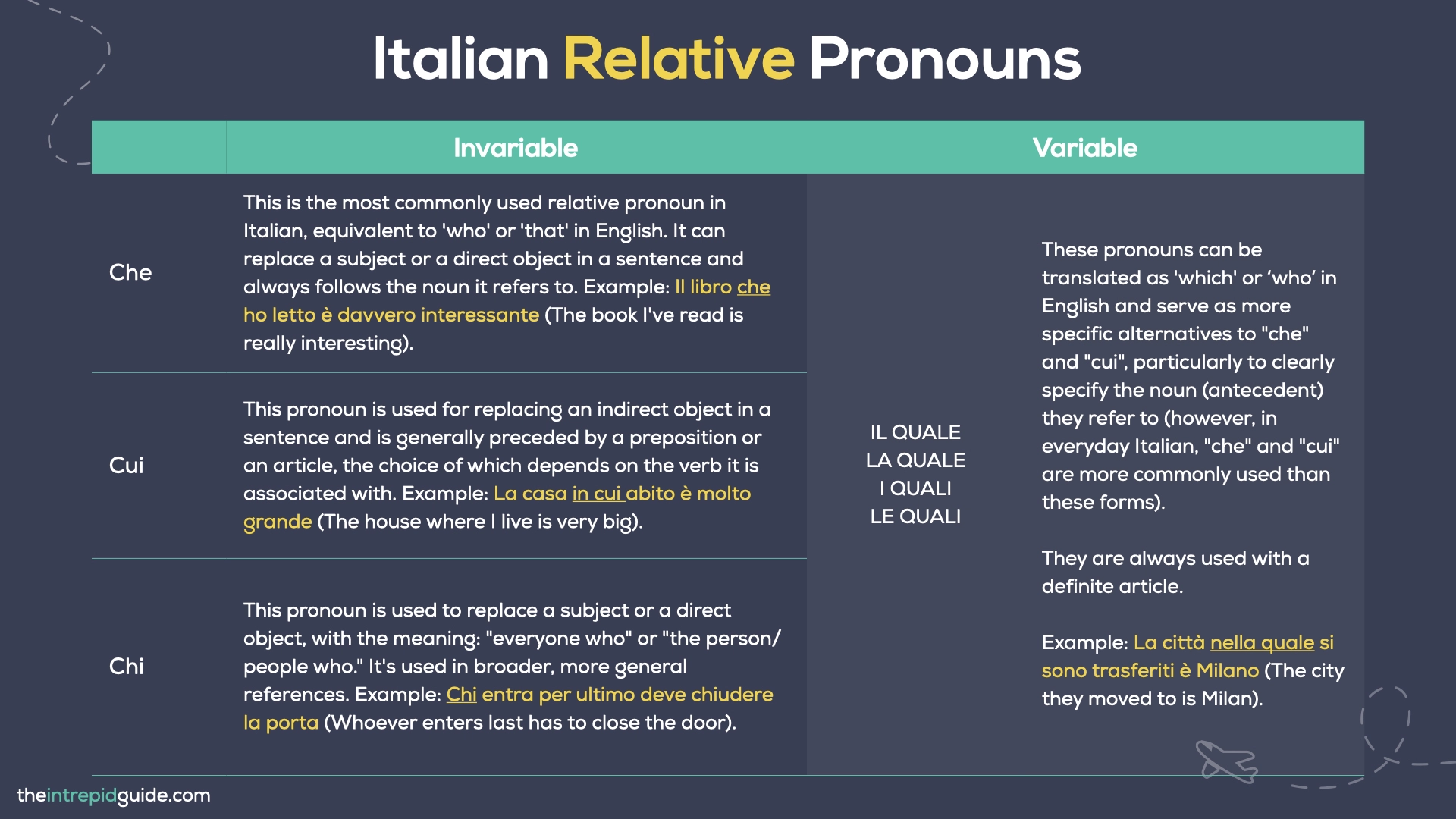 Relative pronouns are used to connect two sentences that share a common element by replacing the noun found in the main clause within the relative clause. Let’s clarify this with two sentences:
Relative pronouns are used to connect two sentences that share a common element by replacing the noun found in the main clause within the relative clause. Let’s clarify this with two sentences:
- Ho parlato con Anna. Anna mi ha detto di chiamarti. (I spoke with Anna. Anna told me to call you.)
These two sentences can be combined into a single sentence as follows:
- Ho parlato con Anna che mi ha detto di chiamarti.(I spoke with Anna, who told me to call you.)
In this combined sentence, the relative pronoun che refers to Anna, so we don’t have to keep saying her name. Relative pronouns in Italian can be divided into two categories: invariable, which means they do not change their form based on the gender and number of the noun they refer to, and variable:
| Italian Relative Pronouns | |||
|---|---|---|---|
| Invariable | Variable | ||
| CHE | This is the most commonly used relative pronoun in Italian, equivalent to ‘who’ or ‘that’ in English. It can replace a subject or a direct object in a sentence and always follows the noun it refers to. Example: Il libro che ho letto è davvero interessante (The book I’ve read is really interesting). | IL QUALE (and its gender and number variants LA QUALE, I QUALI, LE QUALI) | These pronouns can be translated as ‘which’ or ‘who’ in English and serve as more specific alternatives to “che” and “cui”, particularly to clearly specify the noun (antecedent) they refer to (however, in everyday Italian, “che” and “cui” are more commonly used than these forms). They are always used with a definite article. Example: La città nella quale si sono trasferiti è Milano (The city they moved to is Milan). |
| CUI | This pronoun is used for replacing an indirect object in a sentence and is generally preceded by a preposition or an article, the choice of which depends on the verb it is associated with. Example: La casa in cui abito è molto grande (The house where I live is very big). | ||
| CHI | This pronoun is used to replace a subject or a direct object, with the meaning: “everyone who” or “the person/people who.” It’s used in broader, more general references. Example: Chi entra per ultimo deve chiudere la porta (Whoever enters last has to close the door). | ||
Here are some examples:
- Quel ragazzo è molto simpatico. Quel ragazzo lavora al bar.(That guy is really nice. That guy works at the bar.)
- Quel ragazzo che lavora al bar è molto simpatico. (That guy, who works at the bar, is really nice.)
In this case, che refers to quel ragazzo, which functions as the subject of both clauses.
- Ho comprato le mele. Le mele erano buonissime. (I bought apples. The apples were really good)
- Le mele che ho comprato erano buonissime. (The apples I bought were really good.)
Here, che refers back to le mele from the first sentence, where it functions as a direct object.
- Parlavo con quella ragazza. Quella ragazza è austriaca. (I was talking with that girl. That girl is Austrian).
- Quella ragazza con cui parlavo è austriaca.(That girl I was talking to is Austrian.)
Here, cui refers to quella ragazza, which is the indirect object of the verb ‘parlava’ in the first sentence.
- Ho parlato con i suoi fratelli. I suoi fratelli sostengono di non averlo sentito. (I spoke with his brothers. His brothers said they haven’t heard from him.)
- Ho parlato con i suoi fratelli, i quali sostengono di non averlo sentito.(I spoke with his brothers who said they haven’t heard from him.)
Here, i quali serves to link the second part of the sentence back to i suoi fratelli.
Click here to learn more about relative pronouns in Italian
All Italian Pronouns Chart
Here’s a handy table to quickly see all the pronoun types we’ve covered in this guide.
| Key Italian Pronouns | |||||
|---|---|---|---|---|---|
| Subject Pronoun | Direct Object Pronoun | Indirect Object Pronoun | Reflexive Pronouns | Possessive Pronouns | Relative Pronouns |
| i pronomi personali | i pronomi diretti | i pronomi indiretti | i pronomi riflessivi | i pronomi possessivi | i pronomi relativi |
| io | mi, me | mi, me | mi | il mio, i miei, la mia, le mie | che, chi, cui, il quale, la quale, i quali, le quali |
| tu | ti,. te | ti, te | ti | il tuo, i tuoi, la tua, le tue | |
| lui, egli, esso, lei, ella, essa | lo, lui, la, lei, la (formal), lei (formal) | gli, lui, le, lei, le (formal), lei (formal) | si | il suo, i suoi, la sua, le sue | |
| noi | ci, noi | ci, noi | ci | il nostro, i nostri, la nostra, le nostre | |
| voi | vi, voi | vi, voi | vi | il vostro, i vostri, la vostra, le vostre | |
| loro, essi | li, le, loro | gli, loro | si | il loro, i loro, la loro, le loro | |
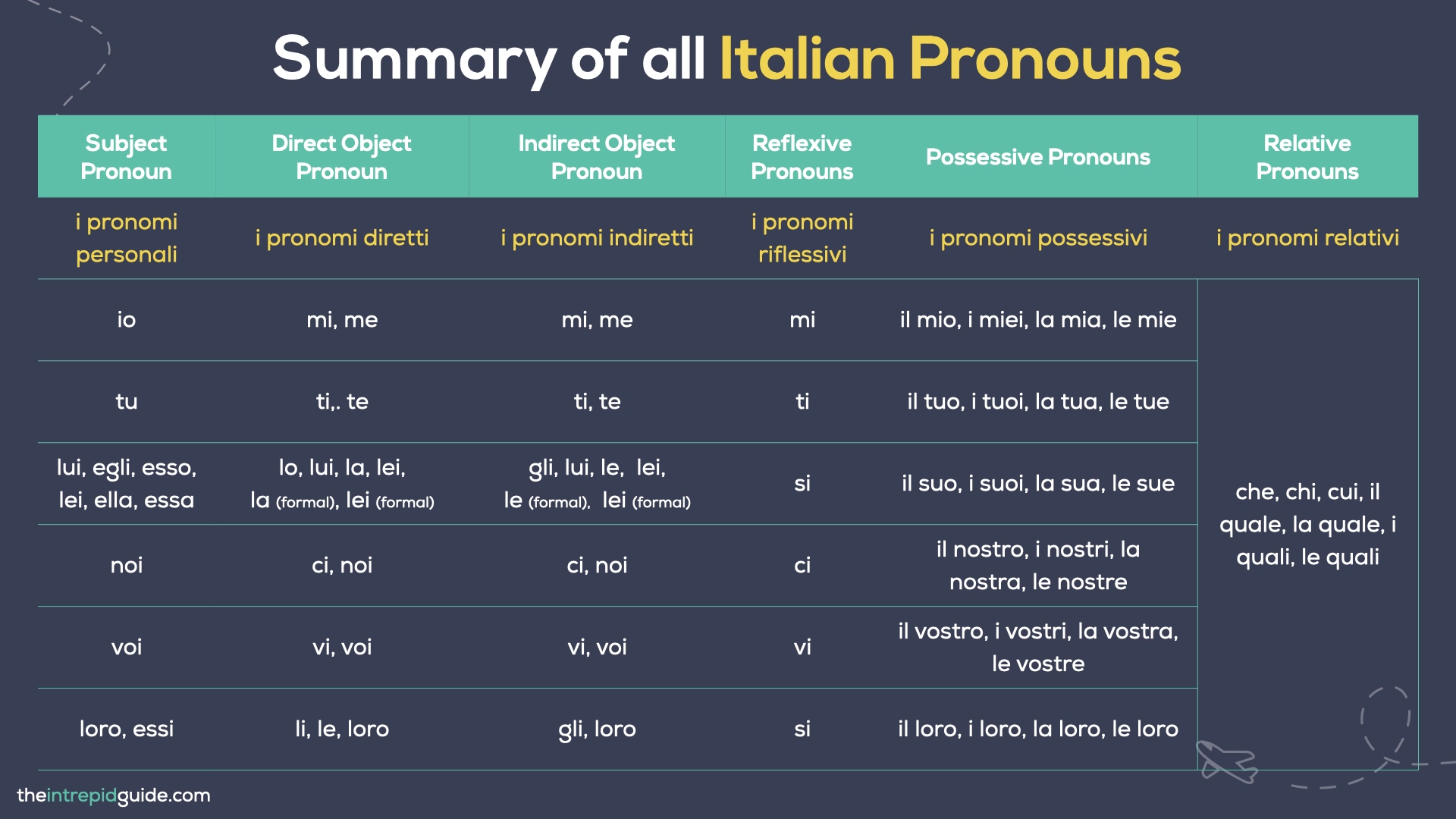
Italian Pronouns Quiz
Alright, time for a fun little quiz to see how well you know the main Italian pronouns. Fill in the blanks in these sentences using the correct pronoun:
If you found this lesson powerful, then you’ll love Intrepid Italian, my series of online self-paced video courses that break down everything you need to know about Italian using my 80/20 method. Visit IntrepidItalian.com for more details.
 Are you a beginner or an intermediate Italian learner? Got a trip coming up or want to communicate with your Italian partner or relatives in Italian? Learn Italian with my unique 80/20 method
Are you a beginner or an intermediate Italian learner? Got a trip coming up or want to communicate with your Italian partner or relatives in Italian? Learn Italian with my unique 80/20 method
Registrations are now open to join Intrepid Italian, my new series of online video courses that use my unique 80/20 method. You’ll go from a shy, confused beginner to a proficient and confident intermediate speaker, with me as your trusty guide.
You’ll finally be able to connect with your Italian partner, speak to your relatives and enjoy authentic travel experiences in Italy that you’ve always dreamed of, and so much more.
As a native English speaker who learned Italian as an adult, I know what it’s like to feel hopeless and lack the confidence to speak. I know what it’s like to start from scratch and to even go back to absolute basics and learn what a verb is!
Intrepid Italian was created with YOU in mind. I use my working knowledge of the English language to help you get into the ‘Italian mindset’ so you can avoid the common pitfalls and errors English speakers make – because I made them once too! I break everything down in such a way that it ‘clicks’ and just makes sense.
No matter what your level is, there is an Intrepid Italian course for you, including:
- 🇮🇹 Intrepid Italian for Beginners (A1)
- 🇮🇹 Intrepid Italian for Advanced Beginners (A2)
- 🇮🇹 Intrepid Italian for Intermediates (B1)
You can join 1, 2, or all 3 courses, it’s entirely up to you. The best part is that you have lifetime access so you learn anytime, anywhere and on any device.
As your guide, I walk you through each lesson, step-by-step, using my unique 80/20 method. My approach is different from traditional methods because I teach you the most important 20% of the language right from the beginning so you can start to speak straight away.
Each course includes video lessons, audio exercises, downloadable worksheets, bonus guides, a private support community, and lifetime access all designed to streamline your learning while having fun.
It even comes with my famous “Celebrate with a Spritz Guarantee”. After 30 days of using Intrepid Italian, if you don’t want to celebrate your new-found Italian skills with an Aperol Spritz, you don’t have to pay a penny! Cheers! 🥂
Join Intrepid Italian here and start learning today!
Ci vediamo lì! (See you there!)
Learning Italian? Check out these Italian language guides
- Italian for Beginners | How to Learn Italian in 3 Simple Steps
- TOP 100 Most Common Italian Words (Plus PDF Cheat-Sheet & Quiz)
- Italian Prepositions:The Only Guide You’ll Ever Need (PLUS Chart)
- 17 Weird Italian Superstitions Italians ACTUALLY Live By
- 17 Must-Know Italian Hand Gestures: The Ultimate Guide
- 10 Ways Natives REALLY Say ‘You’re Welcome’ in Italian
- How to say ‘Please’ in Italian in 9 Ways Like a Native
- 41 Italian Greetings: How to Say ‘Hello’ in Italian Like a Local
- 125 Most Common Italian Phrases for Travel You’ll Ever Need [PLUS Printable]
- 8 DEADLY mistakes in Italian (& How to Avoid Them)
- How to Conjugate Italian Verbs in 3 Simple Steps [Italian for Beginners]
- Is Italian Hard to Learn? 7 Common Mistakes & How to Avoid Them
- Master Days of the Week in Italian (7 Simple Memory Hacks)
- Italian Numbers: How to Count in Italian From 0 to 1 Billion (Plus PDF Download)
- How to Order Food & Drinks in Italian [Italian for Beginners]
- 15 Italian Words You Should NEVER Mispronounce [& How Not To]
- 11 Effective Hacks That’ll Help You Learn Italian So Much Faster
- Top 14 Italian Words You Should NEVER Say [& What to Use Instead]
- 20 Hilarious Everyday Italian Expressions You Should Use
- Romanesco: 25 Cool Roman Dialect Words You Should Use in Rome
- 10 Reasons Why Learning Italian Will Change Your Life
- 10 Italian Expressions Italians Love Saying
- 10 Italian Phrases That Will Instantly Make You Sound more Italian
- Funny Italian Sayings: 26 Food-Related Insults You Won’t Forget
- 15 Romantic Italian Films That’ll Make You Love Italy Even More
- How to Master Common Italian Phrases for Travel (Like a Local!)
Like it? Pin it for later!

Over to you!
Did you enjoy this lesson? Do you have a question? Let me know using the comments section below or join me on social media @intrepidguide or @intrepiditalian to start a conversation.
Thanks for reading and I hope you enjoyed this post.
Like what you see? Subscribe using the form below to have all of my posts delivered directly to your email.

